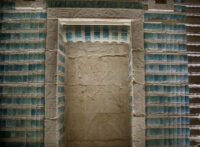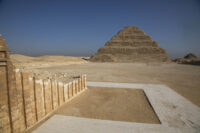 A monumental tomb across from the Step Pyramid of Djoser has reopened to visitors after 15 years of renovations. The Southern Tomb is part of the expansive mortuary complex built by Djoser’s royal architect Imhotep in Saqqara, a necropolis just outside the ancient Egyptian capital of Memphis. Built between 2667 and 2648 B.C., the Southern Tomb is a mastaba, a rectangular tomb with a flat roof (the step pyramid was made by stacking six mastabas on top of each other).
A monumental tomb across from the Step Pyramid of Djoser has reopened to visitors after 15 years of renovations. The Southern Tomb is part of the expansive mortuary complex built by Djoser’s royal architect Imhotep in Saqqara, a necropolis just outside the ancient Egyptian capital of Memphis. Built between 2667 and 2648 B.C., the Southern Tomb is a mastaba, a rectangular tomb with a flat roof (the step pyramid was made by stacking six mastabas on top of each other).
 The limestone building you see on the surface is the figurative tip of the iceberg. Underneath the visible tomb is a labyrinthine warren of passages cut down into the living rock 100 feet below the surface. The long corridors are punctuated by false doors engraved with the hieroglyphics and inlaid with tiles of blue faience. At the base of the central funeral shaft is a massive pink granite sarcophagus, a smaller version of the one inside the burial room of the step pyramid.
The limestone building you see on the surface is the figurative tip of the iceberg. Underneath the visible tomb is a labyrinthine warren of passages cut down into the living rock 100 feet below the surface. The long corridors are punctuated by false doors engraved with the hieroglyphics and inlaid with tiles of blue faience. At the base of the central funeral shaft is a massive pink granite sarcophagus, a smaller version of the one inside the burial room of the step pyramid.
 It’s not certain what the purpose of the tomb was. Djoser’s body was buried in his glorious pyramid. It may have had an unknown symbolic purpose. Mostafa Waziri, secretary-general of Egypt’s Supreme Council of Antiquities, hypothesizes that it was the most glamorous and expensive canopic jar ever, a great monument built to contain his internal organs.
It’s not certain what the purpose of the tomb was. Djoser’s body was buried in his glorious pyramid. It may have had an unknown symbolic purpose. Mostafa Waziri, secretary-general of Egypt’s Supreme Council of Antiquities, hypothesizes that it was the most glamorous and expensive canopic jar ever, a great monument built to contain his internal organs.
 Restoration of the Southern Tomb began in 2006, part of the same comprehensive research and restoration of the necropolis that also shored up the dangerously precarious Step Pyramid, which reopened to visitors last year. The corridors, walls and ceilings under the mastaba were stabilized and new flooring and lighting installed. The granite sarcophagus was also recomposed.
Restoration of the Southern Tomb began in 2006, part of the same comprehensive research and restoration of the necropolis that also shored up the dangerously precarious Step Pyramid, which reopened to visitors last year. The corridors, walls and ceilings under the mastaba were stabilized and new flooring and lighting installed. The granite sarcophagus was also recomposed.

from The History Blog https://ift.tt/3ElyxBp








0 comments:
Post a Comment